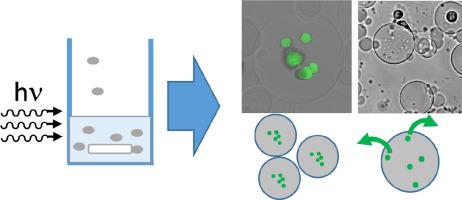当前位置:
X-MOL 学术
›
Eur. Polym. J.
›
论文详情
Our official English website, www.x-mol.net, welcomes your
feedback! (Note: you will need to create a separate account there.)
Microparticles from Glycidylmethacrylated Gelatin as Cell Carriers Prepared in an Aqueous Two-Phase System
European Polymer Journal ( IF 5.8 ) Pub Date : 2021-01-01 , DOI: 10.1016/j.eurpolymj.2020.110148 Axel T. Neffe , Dunia M. Garcia Cruz , Toralf Roch , Andreas Lendlein
European Polymer Journal ( IF 5.8 ) Pub Date : 2021-01-01 , DOI: 10.1016/j.eurpolymj.2020.110148 Axel T. Neffe , Dunia M. Garcia Cruz , Toralf Roch , Andreas Lendlein

|
Abstract Encapsulation by polymeric biomaterials can provide mechanical protection of cells and shielding from the immune system of the host when implanted as cell therapy. At the same time, free exchange of nutrients and metabolites including bioactive molecules guiding regenerative processes is facilitated. Here, glycidylmethacrylated gelatin (GMA-gelatin) is explored as matrix material for adherent (L929 mouse fibroblasts) or non-adherent (Ramos blue) cells by an integrated process of shaping and chemical crosslinking. Microparticle formation was driven by a water-in-water-emulsion technique, which allowed simultaneous irradiation with light of 365 nm in the presence of the photosensitizer irgacure 2959. Suitable photopolymerization conditions were determined in experiments with GMA-gelatin and cells. More than 85% of the cells survived this procedure, and an encapsulation efficiency of up to 75±2% was reached. Diffusivity of molecules up to a molar mass of 150 kg·mol-1 in the matrix was shown by the release of co-encapsulated FITC-labelled dextran. L929 as well as Ramos blue cells proliferated in the microparticle matrix after encapsulation and released enzymes that could be detected in the cell culture medium in an active form. L929 showed the ability to escape the particles over time. Altogether, the presented cell encapsulation system based on a material that is stable to hydrolytic degradation for several weeks is generally suitable for cell based therapy or in vitro test systems.
中文翻译:

来自甲基丙烯酸缩水甘油酯明胶的微粒作为在水性两相系统中制备的细胞载体
摘要 聚合物生物材料的封装可以为细胞提供机械保护,并在作为细胞疗法植入时为宿主的免疫系统提供保护。同时,促进了营养物质和代谢物的自由交换,包括引导再生过程的生物活性分子。在这里,甲基丙烯酸缩水甘油酯明胶(GMA-明胶)通过成型和化学交联的综合过程被探索作为粘附(L929 小鼠成纤维细胞)或非粘附(拉莫斯蓝)细胞的基质材料。微粒形成由水包水乳液技术驱动,该技术允许在光敏剂 irgacure 2959 存在下同时用 365 nm 光照射。在 GMA-明胶和细胞实验中确定了合适的光聚合条件。超过 85% 的细胞在这个过程中存活下来,并且达到了高达 75±2% 的封装效率。共封装的 FITC 标记的葡聚糖的释放显示了分子在基质中的扩散率高达 150 kg·mol-1 的摩尔质量。L929 以及拉莫斯蓝细胞在封装后在微粒基质中增殖并释放酶,这些酶可以在细胞培养基中以活性形式检测到。L929 显示出随着时间的推移逃离粒子的能力。总而言之,所提出的细胞封装系统基于对水解降解稳定数周的材料,通常适用于基于细胞的治疗或体外测试系统。共封装的 FITC 标记的葡聚糖的释放显示了分子在基质中的扩散率高达 150 kg·mol-1 的摩尔质量。L929 以及拉莫斯蓝细胞在封装后在微粒基质中增殖并释放酶,这些酶可以在细胞培养基中以活性形式检测到。L929 显示出随着时间的推移逃离粒子的能力。总而言之,所提出的细胞封装系统基于对水解降解稳定数周的材料,通常适用于基于细胞的治疗或体外测试系统。共封装的 FITC 标记的葡聚糖的释放显示了分子在基质中的扩散率高达 150 kg·mol-1 的摩尔质量。L929 以及拉莫斯蓝细胞在封装后在微粒基质中增殖并释放酶,这些酶可以在细胞培养基中以活性形式检测到。L929 显示出随着时间的推移逃离粒子的能力。总而言之,所提出的细胞封装系统基于对水解降解稳定数周的材料,通常适用于基于细胞的治疗或体外测试系统。L929 显示出随着时间的推移逃离粒子的能力。总而言之,所提出的细胞封装系统基于对水解降解稳定数周的材料,通常适用于基于细胞的治疗或体外测试系统。L929 显示出随着时间的推移逃离粒子的能力。总而言之,所提出的细胞封装系统基于对水解降解稳定数周的材料,通常适用于基于细胞的治疗或体外测试系统。
更新日期:2021-01-01
中文翻译:

来自甲基丙烯酸缩水甘油酯明胶的微粒作为在水性两相系统中制备的细胞载体
摘要 聚合物生物材料的封装可以为细胞提供机械保护,并在作为细胞疗法植入时为宿主的免疫系统提供保护。同时,促进了营养物质和代谢物的自由交换,包括引导再生过程的生物活性分子。在这里,甲基丙烯酸缩水甘油酯明胶(GMA-明胶)通过成型和化学交联的综合过程被探索作为粘附(L929 小鼠成纤维细胞)或非粘附(拉莫斯蓝)细胞的基质材料。微粒形成由水包水乳液技术驱动,该技术允许在光敏剂 irgacure 2959 存在下同时用 365 nm 光照射。在 GMA-明胶和细胞实验中确定了合适的光聚合条件。超过 85% 的细胞在这个过程中存活下来,并且达到了高达 75±2% 的封装效率。共封装的 FITC 标记的葡聚糖的释放显示了分子在基质中的扩散率高达 150 kg·mol-1 的摩尔质量。L929 以及拉莫斯蓝细胞在封装后在微粒基质中增殖并释放酶,这些酶可以在细胞培养基中以活性形式检测到。L929 显示出随着时间的推移逃离粒子的能力。总而言之,所提出的细胞封装系统基于对水解降解稳定数周的材料,通常适用于基于细胞的治疗或体外测试系统。共封装的 FITC 标记的葡聚糖的释放显示了分子在基质中的扩散率高达 150 kg·mol-1 的摩尔质量。L929 以及拉莫斯蓝细胞在封装后在微粒基质中增殖并释放酶,这些酶可以在细胞培养基中以活性形式检测到。L929 显示出随着时间的推移逃离粒子的能力。总而言之,所提出的细胞封装系统基于对水解降解稳定数周的材料,通常适用于基于细胞的治疗或体外测试系统。共封装的 FITC 标记的葡聚糖的释放显示了分子在基质中的扩散率高达 150 kg·mol-1 的摩尔质量。L929 以及拉莫斯蓝细胞在封装后在微粒基质中增殖并释放酶,这些酶可以在细胞培养基中以活性形式检测到。L929 显示出随着时间的推移逃离粒子的能力。总而言之,所提出的细胞封装系统基于对水解降解稳定数周的材料,通常适用于基于细胞的治疗或体外测试系统。L929 显示出随着时间的推移逃离粒子的能力。总而言之,所提出的细胞封装系统基于对水解降解稳定数周的材料,通常适用于基于细胞的治疗或体外测试系统。L929 显示出随着时间的推移逃离粒子的能力。总而言之,所提出的细胞封装系统基于对水解降解稳定数周的材料,通常适用于基于细胞的治疗或体外测试系统。











































 京公网安备 11010802027423号
京公网安备 11010802027423号